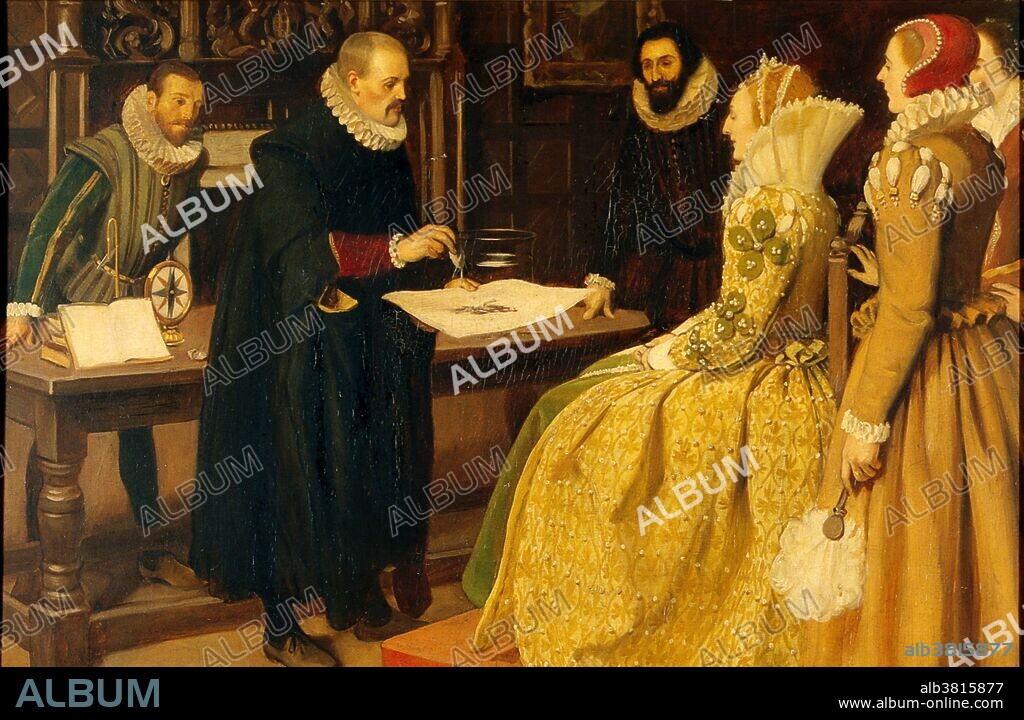alb3815877
William Gilbert Demonstrating Magnet, 1598

|
Add to another lightbox |
|
Add to another lightbox |



Buy this image.
Select the use:

Title:
William Gilbert Demonstrating Magnet, 1598
Caption:
William Gilbert demonstrating the magnet before Queen Elizabeth in 1598. Oil painting by Ernest Board. William Gilbert (1544-1603) was an English physician, physicist and natural philosopher whose primary scientific work was De Magnete... (1600) (On the Magnet and Magnetic Bodies, and on the Great Magnet the Earth), and who is credited as one of the originators of the term "electricity." A unit of magnetomotive force, also known as magnetic potential, was named the Gilbert in his honor. In De Magnete, he describes many of his experiments with his model Earth called the terrella. From these experiments, he concluded that the Earth was itself magnetic and that this was the reason compasses point north (previously, some believed that it was the pole star (Polaris) or a large magnetic island on the north pole that attracted the compass). He was the first to argue, correctly, that the centre of the Earth was iron, and he considered an important and related property of magnets was that they can be cut, each forming a new magnet with north and south poles.
Credit:
Album / Science Source / Wellcome Images
Releases:
Model: No - Property: No
Rights questions?
Rights questions?
Image size:
3750 x 2442 px | 26.2 MB
Print size:
31.8 x 20.7 cm | 12.5 x 8.1 in (300 dpi)
Keywords:
1500S • 16 16TH XVI XVITH SIXTEENTH CENTURY • 16 CENTURY • 1600S • 16TH CENTURY • 16TH • 17TH CENTURY • ART • ARTWORK • CELEBRITIES • CELEBRITY • DE MAGNETE • DEMONSTRATING • DRAWING • EARTH'S MAGNETIC FIELD • ELECTRICITY TERM • ELIZABETH 1ST • ELIZABETH I • ENGLISH • EUROPEA • EUROPEAN • EUROPEANS • FAMOUS PEOPLE • FAMOUS • FIGURE • GEOMAGNETIC FIELD • GEOMAGNETISM DISCOVERER • GILBERD • GILBERT • HISTORIC • HISTORICAL • HISTORY • ILLUSTRATION • ILLUSTRATIONS • IMPORTANT • INVENTOR (MALE) • INVENTOR • MAGNET • MAGNETIC FIELD • MAGNETISM • MALE • MAN • MEN • NATURAL PHILOSOPHER • NATURAL PHILOSOPHY • NOTABLE • PAINTING • PEOPLE • PERSON • PERSONALITIES • PERSONALITY • PHYSICIST • PHYSICS • PORTRAIT • POTRAIT • QUEEN • SAVANT • SCIENCE • SCIENTIFIC DEMONSTRATION • SCIENTIFIC • SCIENTIST • SHOWING • W. GILBERT • WELL-KNOWN • WILLIAM GILBERT • XVI CENTURY
 Pinterest
Pinterest Twitter
Twitter Facebook
Facebook Copy link
Copy link Email
Email
